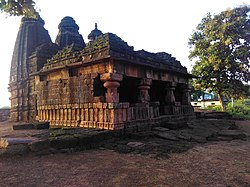|
Gadchiroli district
Gadchiroli district (Marathi pronunciation: [ɡəɖt͡ʃiɾoliː]) is an administrative district in Maharashtra, India. The city of Gadchiroli is the administrative headquarters of the district. OfficerMembers of ParliamentGuardian Minister
List of Guardian Minister
District Magistrate/Collector
list of District Magistrate / Collector
Extent and historyMaharashtra tapers in the east, where this district forms the south-east corner. The district is bordered by Gondia district to the north, Mohla-Manpur-Ambagarh Chowki, Kanker, Narayanpur and Bijapur districts of Chhattisgarh to the east, Jayashankar Bhupalpally district of Telangana to the south, and Mancherial and Komaram Bheem districts of Telangana and Chandrapur district to the west. Gadchiroli District was created on 26 August 1982 by the separation of Gadchiroli and Sironcha talukas from Chandrapur district. Strategic planningThe district is currently a part of the Red Corridor, in the eastern, central and southern parts of India where the Naxalite–Maoist insurgency has the strongest presence.[1] DivisionsThe district is divided into six revenue sub-divisions:Gadchiroli, Aheri,Chamorshi,Etapalli,Wadsa(Desaiganj),Kurkheda. These are each further divided into 2 taluka. Gadchiroli sub-division consists of Gadchiroli and Dhanora, Chamorshi sub-division consist of chamorshi and Mulchera talukas; Aheri sub-division consists of Aheri and Sironcha.Etapalli sub-division cover Etapalli and Bhamragad talukas; and Desaiganj (Wadsa) sub-division consists of Wadsa and Armori.Kurkheda sub-division consist of Kurkheda and Korchi talukas. There are 557 gram panchayats (village councils) and 1,688 Revenue Villages. The district has 12 panchayat samitis (local development-block governments). Only three municipalities, Gadchiroli, Wadsa (Desaiganj), and Armori exist in the district. Following the delimitation of the constituencies in 2008, the district had three Vidhan Sabha (legislative assembly) constituencies: Gadchiroli, Armori and Aheri. All of these are part of the newly carved Gadchiroli-Chimur Lok Sabha constituency.[2] Natural geographyEstablished on 26 August 1982 The main river basin of the district is the Godavari, which flows west-to-east and forms the southern boundary of the district. The major tributaries of the Godavari are the Indravati and the Pranhita, the latter of which is formed by the confluence of the Wainganga and the Wardha near Chaprala village of Chamorshi taluka. Dhanora, Etapalli, Aheri and Sironcha talukas in the eastern part of the district are covered by forest. Hills are found in Bhamragad, Tipagad, Palasgad and Surjagad area. The eastern part of Gadchiroli, bordering Chhattisgarh state, is mainly hilly and is tribal-dominated, similar to neighbouring Bastar region in Chhattisgarh. Demographics
According to the 2011 census Gadchiroli district has a population of 1,072,942,[4] roughly equal to the nation of Cyprus[5] or the US state of Rhode Island.[6] This gives it a ranking of 424th in India (out of a total of 640).[4] The district has a population density of 74 inhabitants per square kilometre (190/sq mi).[4] Its population growth rate during 2001–2011 was 10.46%.[4] Gadchiroli has a sex ratio of 975 females for every 1000 males,[4] and a literacy rate of 70.55%.[4] 11.00% of the population lived in urban areas. Scheduled castes and Scheduled Tribes made up 120,745 (11.25%) and 415,306 (38.71%) of the population respectively. Almost 85% of the tribals are Gonds, in particular the Madia Gonds.[7]
LanguagesAt the time of the 2011 Census of India, 56.08% of the population in the district spoke Marathi, 14.01% Gondi, 9.44% Santali, 8.87% Telugu, 5.12% Bengali, 2.15% Hindi and 1.69% Chhattisgarhi as their first language.[10] Marathi is the main language in the western and northern parts of the district, while Chhattisgarhi is spoken in Korchi tehsil. Gondi is the dominant language in the eastern parts. Bengali is spoken by refugees in Mulchera tehsil. Telugu speakers are majority in Sironcha tehsil in the far south.[10] As of 2011[update] it is the second-least-populous district of Maharashtra (out of 39), after Sindhudurg.[4] EconomyThe district is categorised as tribal and undeveloped, with farming as the main occupation. Forests cover more than 79.36% of the hilly geographical of the district. The district produces bamboo and Tendu leaves, and paddy is the main agricultural product. Other agriculture includes sorghum, linseed, pigeon pea (tur), and wheat. The only large-scale industry in the district is a paper mill at Ashti in Chamorshi taluka and the paper pulp factory at Desaiganj. There are many rice mills in the district. The Tussar silk worm centre is in Armori taluka. 18.5 kilometres (11.5 mi) of railway lines pass through the district. The district is known for activity of Naxalites – the People's Liberation Guerrilla Army – who have taken shelter in the dense forests and hills. In 2006 the Ministry of Panchayati Raj named Gadchiroli among the country's 250 most-backward districts (out of a total of 640).[11] It is one of the twelve districts in Maharashtra currently receiving funds from the Backward Regions Grant Fund Programme (BRGF).[11] HealthThe Lok Biradari Prakalpa (LBP) situated at Hemalkasa in the Bhamragad taluka is one of the major institutions offering healthcare and education services to the local Madia Gond tribals. LBP was envisioned by the late Gandhian, Dr. Murlidhar Devidas Amte, fondly called Baba Amte. His family consisting of Dr. Prakash Amte, Dr. Mandakini Amte and their children currently work at the LBP.[12][better source needed] EducationThe government recently established Gondwana University on dated 27 September 2011 in Gadhchiroli district.[13] High schools• Global media Kerala model E/M school,allapalli.
Model school Aheri
Senior (degree) colleges
Sainath Adhayapak vidyalaya, Murkhala Prof.Jogendra kawade college Vairagad Shri govindrao Munghate Art and Science college kurkheda
Gadchiroli
Gadchiroli
Important places
See alsoReferences
External linksWikimedia Commons has media related to Gadchiroli district. |
|||||||||||||||||||||||||||||||||||||||||||||||||||||||||||||||||||||||||||||||||||||||||||||||||||||||||||||||||||||||||||||||||||||||||||||||||||||||||||||||||||||||||||||||||||||||||||||||||||||||||||||||||||








